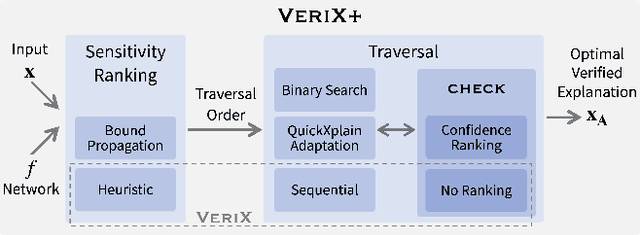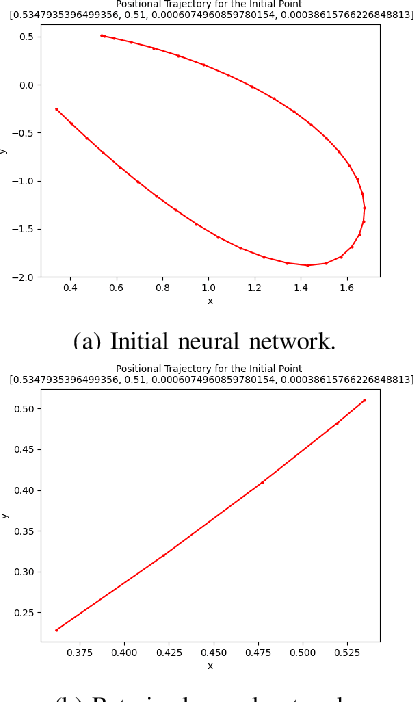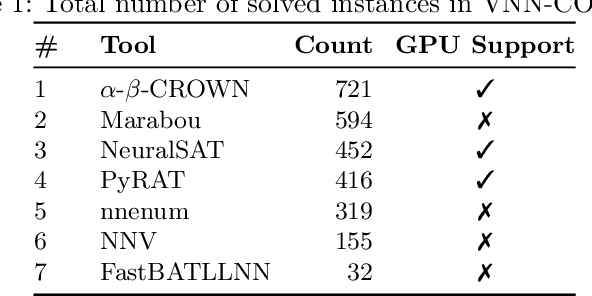Clark Barrett
Stanford University
Proof-Driven Clause Learning in Neural Network Verification
Mar 15, 2025Abstract:The widespread adoption of deep neural networks (DNNs) requires efficient techniques for safety verification. Existing methods struggle to scale to real-world DNNs, and tremendous efforts are being put into improving their scalability. In this work, we propose an approach for improving the scalability of DNN verifiers using Conflict-Driven Clause Learning (CDCL) -- an approach that has proven highly successful in SAT and SMT solving. We present a novel algorithm for deriving conflict clauses using UNSAT proofs, and propose several optimizations for expediting it. Our approach allows a modular integration of SAT solvers and DNN verifiers, and we implement it on top of an interface designed for this purpose. The evaluation of our implementation over several benchmarks suggests a 2X--3X improvement over a similar approach, with specific cases outperforming the state of the art.
Pantograph: A Machine-to-Machine Interaction Interface for Advanced Theorem Proving, High Level Reasoning, and Data Extraction in Lean 4
Oct 21, 2024Abstract:Machine-assisted theorem proving refers to the process of conducting structured reasoning to automatically generate proofs for mathematical theorems. Recently, there has been a surge of interest in using machine learning models in conjunction with proof assistants to perform this task. In this paper, we introduce Pantograph, a tool that provides a versatile interface to the Lean 4 proof assistant and enables efficient proof search via powerful search algorithms such as Monte Carlo Tree Search. In addition, Pantograph enables high-level reasoning by enabling a more robust handling of Lean 4's inference steps. We provide an overview of Pantograph's architecture and features. We also report on an illustrative use case: using machine learning models and proof sketches to prove Lean 4 theorems. Pantograph's innovative features pave the way for more advanced machine learning models to perform complex proof searches and high-level reasoning, equipping future researchers to design more versatile and powerful theorem provers.
Better Verified Explanations with Applications to Incorrectness and Out-of-Distribution Detection
Sep 04, 2024



Abstract:Building on VeriX (Verified eXplainability, arXiv:2212.01051), a system for producing optimal verified explanations for machine learning model outputs, we present VeriX+, which significantly improves both the size and the generation time of verified explanations. We introduce a bound propagation-based sensitivity technique to improve the size, and a binary search-based traversal with confidence ranking for improving time -- the two techniques are orthogonal and can be used independently or together. We also show how to adapt the QuickXplain (Junker 2004) algorithm to our setting to provide a trade-off between size and time. Experimental evaluations on standard benchmarks demonstrate significant improvements on both metrics, e.g., a size reduction of 38% on the GTSRB dataset and a time reduction of 90% on MNIST. We also explore applications of our verified explanations and show that explanation size is a useful proxy for both incorrectness detection and out-of-distribution detection.
Safe and Reliable Training of Learning-Based Aerospace Controllers
Jul 09, 2024


Abstract:In recent years, deep reinforcement learning (DRL) approaches have generated highly successful controllers for a myriad of complex domains. However, the opaque nature of these models limits their applicability in aerospace systems and safety-critical domains, in which a single mistake can have dire consequences. In this paper, we present novel advancements in both the training and verification of DRL controllers, which can help ensure their safe behavior. We showcase a design-for-verification approach utilizing k-induction and demonstrate its use in verifying liveness properties. In addition, we also give a brief overview of neural Lyapunov Barrier certificates and summarize their capabilities on a case study. Finally, we describe several other novel reachability-based approaches which, despite failing to provide guarantees of interest, could be effective for verification of other DRL systems, and could be of further interest to the community.
Formally Verifying Deep Reinforcement Learning Controllers with Lyapunov Barrier Certificates
May 22, 2024Abstract:Deep reinforcement learning (DRL) is a powerful machine learning paradigm for generating agents that control autonomous systems. However, the "black box" nature of DRL agents limits their deployment in real-world safety-critical applications. A promising approach for providing strong guarantees on an agent's behavior is to use Neural Lyapunov Barrier (NLB) certificates, which are learned functions over the system whose properties indirectly imply that an agent behaves as desired. However, NLB-based certificates are typically difficult to learn and even more difficult to verify, especially for complex systems. In this work, we present a novel method for training and verifying NLB-based certificates for discrete-time systems. Specifically, we introduce a technique for certificate composition, which simplifies the verification of highly-complex systems by strategically designing a sequence of certificates. When jointly verified with neural network verification engines, these certificates provide a formal guarantee that a DRL agent both achieves its goals and avoids unsafe behavior. Furthermore, we introduce a technique for certificate filtering, which significantly simplifies the process of producing formally verified certificates. We demonstrate the merits of our approach with a case study on providing safety and liveness guarantees for a DRL-controlled spacecraft.
Towards Guaranteed Safe AI: A Framework for Ensuring Robust and Reliable AI Systems
May 10, 2024



Abstract:Ensuring that AI systems reliably and robustly avoid harmful or dangerous behaviours is a crucial challenge, especially for AI systems with a high degree of autonomy and general intelligence, or systems used in safety-critical contexts. In this paper, we will introduce and define a family of approaches to AI safety, which we will refer to as guaranteed safe (GS) AI. The core feature of these approaches is that they aim to produce AI systems which are equipped with high-assurance quantitative safety guarantees. This is achieved by the interplay of three core components: a world model (which provides a mathematical description of how the AI system affects the outside world), a safety specification (which is a mathematical description of what effects are acceptable), and a verifier (which provides an auditable proof certificate that the AI satisfies the safety specification relative to the world model). We outline a number of approaches for creating each of these three core components, describe the main technical challenges, and suggest a number of potential solutions to them. We also argue for the necessity of this approach to AI safety, and for the inadequacy of the main alternative approaches.
Markovian Agents for Truthful Language Modeling
Apr 29, 2024Abstract:Chain-of-Thought (CoT) reasoning could in principle enable a deeper understanding of a language model's (LM) internal reasoning. However, prior work suggests that some LMs answer questions similarly despite changes in their CoT, suggesting that those models are not truly using the CoT. We propose a training method to produce CoTs that are sufficient alone for predicting future text, independent of other context. This methodology gives a guarantee that if the LM can predict future tokens, then it must have used the CoT to understand its context. We formalize the idea that the truthfulness of a sender to a receiver LM is the degree to which the sender helps the receiver predict their future observations. Then we define a "Markovian" LM as one which predicts future text given only a CoT as context. We derive a "Markovian training" procedure by applying our definition of truthfulness to a Markovian LM and optimizing via policy gradient and Proximal Policy Optimization (PPO). We demonstrate the effectiveness of our training algorithm on long-context arithmetic problems, show that the model utilizes the CoT, and validate that the generated CoT is meaningful and usable by other models.
Marabou 2.0: A Versatile Formal Analyzer of Neural Networks
Jan 25, 2024


Abstract:This paper serves as a comprehensive system description of version 2.0 of the Marabou framework for formal analysis of neural networks. We discuss the tool's architectural design and highlight the major features and components introduced since its initial release.
Towards Efficient Verification of Quantized Neural Networks
Dec 27, 2023



Abstract:Quantization replaces floating point arithmetic with integer arithmetic in deep neural network models, providing more efficient on-device inference with less power and memory. In this work, we propose a framework for formally verifying properties of quantized neural networks. Our baseline technique is based on integer linear programming which guarantees both soundness and completeness. We then show how efficiency can be improved by utilizing gradient-based heuristic search methods and also bound-propagation techniques. We evaluate our approach on perception networks quantized with PyTorch. Our results show that we can verify quantized networks with better scalability and efficiency than the previous state of the art.
Efficiently Programming Large Language Models using SGLang
Dec 12, 2023Abstract:Large language models (LLMs) are increasingly used for complex tasks requiring multiple chained generation calls, advanced prompting techniques, control flow, and interaction with external environments. However, efficient systems for programming and executing these applications are lacking. To bridge this gap, we introduce SGLang, a Structured Generation Language for LLMs. SGLang is designed for the efficient programming of LLMs and incorporates primitives for common LLM programming patterns. We have implemented SGLang as a domain-specific language embedded in Python, and we developed an interpreter, a compiler, and a high-performance runtime for SGLang. These components work together to enable optimizations such as parallelism, batching, caching, sharing, and other compilation techniques. Additionally, we propose RadixAttention, a novel technique that maintains a Least Recently Used (LRU) cache of the Key-Value (KV) cache for all requests in a radix tree, enabling automatic KV cache reuse across multiple generation calls at runtime. SGLang simplifies the writing of LLM programs and boosts execution efficiency. Our experiments demonstrate that SGLang can speed up common LLM tasks by up to 5x, while reducing code complexity and enhancing control.
 Add to Chrome
Add to Chrome Add to Firefox
Add to Firefox Add to Edge
Add to Edge